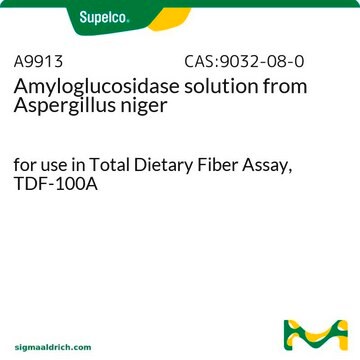A4582
α-Amylase from Bacillus licheniformis
suitable for determination of starch (Kit STA-20)
Synonym(s):
1,4-α-D-Glucan-glucanohydrolase
Sign Into View Organizational & Contract Pricing
All Photos(1)
About This Item
Recommended Products
form
liquid
Quality Level
analyte chemical class(es)
sugars
technique(s)
photometry: suitable
suitability
suitable for determination of starch (Kit STA-20)
application(s)
food and beverages
general analytical
storage temp.
2-8°C
Looking for similar products? Visit Product Comparison Guide
General description
α-Amylase belongs to glycosyl hydrolase family 13.
Application
α-Amylase from Bacillus licheniformis has been used in two-step hydrolysis for enzymatic saccharification of dried biomass powder. It has also been used to analyse the starch concentration by an enzymatic method.
Biochem/physiol Actions
α-Amylase, the digestive enzyme in saliva has several significance in industries like, food, pharmaceutical, textile and paper. It hydrolyses the linear chain of amylose to form glucose molecules.
Signal Word
Danger
Hazard Statements
Precautionary Statements
Hazard Classifications
Resp. Sens. 1
Storage Class Code
11 - Combustible Solids
WGK
WGK 3
Personal Protective Equipment
dust mask type N95 (US), Eyeshields, Gloves
Choose from one of the most recent versions:
Already Own This Product?
Find documentation for the products that you have recently purchased in the Document Library.
Customers Also Viewed
An overview of the microbial alpha-amylase family
Reddy NS, et al.
African Journal of Biotechnology, 2(12), 645- 648 (2003)
The response of rice grain quality to ozone exposure during growth depends on ozone level and genotype
Frei M, et al.
Environmental Pollution (Barking, Essex : 1987), 163, 199- 206 (2012)
SALIVARY GLANDS AND OESOPHAGUS
Digestive Disease Pathology (2010)
Agricultural Residues as Animal Feed: Protein Enrichment and Detoxification Using Solid-State Fermentation
Current Developments in Biotechnology and Bioengineering, 235- 256 (2018)
Changjiang Yu et al.
Biotechnology for biofuels, 10, 167-167 (2017-07-04)
Duckweed is considered a promising source of energy due to its high starch content and rapid growth rate. Starch accumulation in duckweed involves complex processes that depend on the balanced expression of genes controlled by various environmental and endogenous factors.
Our team of scientists has experience in all areas of research including Life Science, Material Science, Chemical Synthesis, Chromatography, Analytical and many others.
Contact Technical Service











